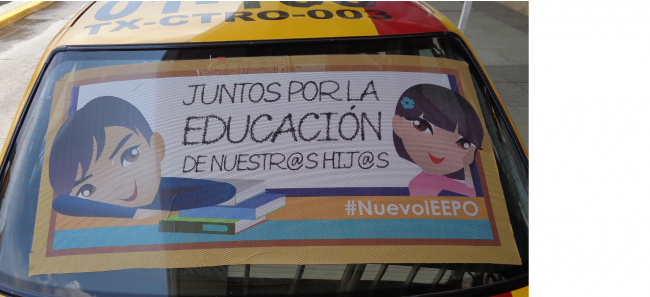Ten years ago, one of the most radical unions in the hemisphere, the Sección XXII of Mexico’s National Education Workers’ Union (SNTE), led a vibrant movement against the state governor’s heavy-handed rule in the southern Mexican state of Oaxaca. The demonstrations, known to many as the “Oaxaca Commune,” featured six months of mass marches, public encampments, and neighborhood barricades. Although they failed to oust the state’s then-governor, Ulises Ruíz Ortíz, the protestors proved that the radical democracy of everyday people – and not just union officials or opposition politicians – could challenge the PRI, which had ruled the state for decades.
In July of this year, however, the panorama for social change in Oaxaca seemed to radically change. In the name of enforcing an expansive national education reform, current Oaxaca governor Gabino Cué froze union bank accounts, abrogated contractual agreements, dismantled the state education agency, and asked for thousands of federal soldiers to make sure the school year started without a repeat of the events of 2006. Tellingly, Cué has refused to charge Ruíz Ortíz with a crime, although the state’s Truth Commission has repeatedly requested that the former governor testify
Now, the union that has led fights for democracy since the 1980s can barely cash its checks. Instead of facing off with the PRI-led state government, as in 2006, this time the union is up against global financiers, national economic elites, its own national union, and all the major political parties in Mexico. Each of these groups support a constitutional reform that would privatize schools, punitively evaluate teachers, and standardize education.
The measure threatens some of the last-standing legacies of the social rights won in the Mexican Revolution, among them the guarantee of a free public education and basic job security. In November, more than 1,000 education specialists in Mexico signed a letter arguing that the governmental reforms “lack an educational project” and were passed without properly consulting educators. As Lois Meyer and Ricardo Rosa have argued, the resistance to corporate education measures in Oaxaca continues as similar policies come under fire in the U.S.
In Oaxaca this August, I observed firsthand the vast public relations campaign the government initiated to frame the debate. For one, it weakened the position of the state’s education workers through an “air war” of classic scapegoating techniques. The media blitz simplified a multifaceted matter like education into a single and distinct “problem,” and identified the source of the problem within a vocal but vulnerable population – Oaxaca’s teachers. In the process, the media demonized and thereby isolated them from the broader public. Casting educators as selfish, corrupt, and prone to antiquated types of violent protest, the caricature of the teachers that has emerged presents them as anti-democratic, parasitically living off el pueblo and subservient to all-powerful union leaders.
The image the government has drawn of the teachers and their union resonates because it draws upon material realities and takes advantage of existing social tensions. Many Oaxacans were frustrated with school days cancelled for teachers’ marches and strikes – and the media campaign capitalized on this discontent by questioning the legitimacy of the teachers’ claims. While indigenous and peasant organizations have long collaborated with the union, the media’s persistent displays of select leaders’ illegitimate earnings – rather than on the lives of everyday teachers or on the corruption of government-appointed education functionaries – likely amplified tensions about economic differences between unionists and indigenous agriculturalists. Education workers have long enjoyed job security and stable, if modest, paychecks, while peasants and informal sector workers have faced increasingly precarious conditions. Though many indigenous organizations continue to support the union, their collaboration has been less prominent in 2015 than in 2006, when teachers and hundreds of other organizations and communities formed the radical and democratic Popular Assembly of the Peoples of Oaxaca (APPO).
In marked contrast to the portrayal of the teachers, the public relations campaign cast the new state education agency as democratically inclusive, child-oriented, and smoothly modern. The new agency, called the New State Institute of Public Education of Oaxaca (Nuevo IEEPO), heralded itself as reflecting Gabino Cué’s slogan of “government for everyone,” as the sign emblazoned on thousands of taxicabs and billboards suggested. Despite its claims of openness, the reforms explicitly restrict union participation.

<
The imposition of education reforms has undoubtedly produced a new political environment in Oaxaca. The formerly crowded downtown Sección XXII building is now much quieter. The reform slashed funds used to pay long-term substitutes for teachers elected to positions in union educational development and administration, so elected leaders are now forced to stay in their classrooms. In this rural, mountainous, and heavily indigenous state, many teachers travel hours – and often brave washed-out roads – to get to work. Many of their students walk several miles to attend school.
Teachers often argue that these structural conditions – as well as the vast ethnic and linguistic diversity of the state – are why student and teacher performance shouldn’t be punitively measured and compared against rich schools in Mexico or those in the Organization for Economic Cooperation and Development (OECD) countries. In fact, the OECD itself has recently substantiated the union’s argument that under-resourcing education is the real problem. OECD Chief of Staff Gabriela Ramos recently noted that Mexico spends less per student than any other OECD country.
The educational reforms also threaten to further damage bonds between education workers and the rest of the public, the very bonds that galvanized the 2006 insurgency. Even as Mexico remains one of the most dangerous places in the world for those who expose high-level abuses of power, the reforms encourage citizens to patrol their peers in the name of attacking corruption. Instead of solidarity, they spur surveillance. The governor, for example, asked municipal presidents to send local police to monitor teachers’ attendance and recruit strikebreakers. On the Nuevo IEEPO’s website, viewers can’t submit ideas about education, but they can report teachers who miss class. Such denunciations are of considerable political value to the government now, since they delegitimize its most powerful opponents. The broader culture of scrutiny these measures help create responds to the contemporary political clamor for accountability and anti-corruption measures, yet media investigations link the Nuevo IEEPO to corruption as well. In addition, citizens and educators have recounted their frustrations with the lack of basic operational capacity of the new institution.
The atmosphere of vigilance and accusation the reforms generate could also wear down community cohesion, and this “slow” violence of simmering distrust has been matched by the prospect of the “fast” violence of massive police and military presence, as well as the continued prospect of extrajudicial death or disappearance. In the year following the disappearances of 43 education students, who were protesting education reforms in the state of Guerrero, four teachers have been killed. The state has also imprisoned four of Oaxaca’s teacher leaders, and issued arrest warrants for dozens of others. Many others have been arrested or intimidated.
When I was in Oaxaca in August, the police and military combined spectacular threat – phalanxes of low-flying military helicopters, for instance – with silent, subtle efforts to militarize society. When teachers threatened to strike during the first week of classes in August, the federal police entered schools under the premise of remodeling them. A police official pledged, however, that they were “ready for any kind of situation.” For several days straight in Oaxaca City’s Santo Domingo Plaza, federal police camped out next to street fairs. With their new vehicles glistening, they invited children to honk their horns, test the radios, and touch the gun mounts. As I saw firsthand in Oaxaca, the government also paid for many of the police to reside in fancy hotels in the city center. The starting price for an individual room in one was 990 pesos, more than 12 times the daily earnings of a minimum wage Mexican worker.

Regardless of the new conditions, my conversations with teachers in the last few months suggest that resistance to the reforms will continue, even if the rules of the game are rapidly changing. Like in 2006, that resistance will likely operate outside the official spheres of political life. Education workers in the CNTE continue to engage in major one-day strikes and blockades of the sites for new teacher’s evaluation exams, one of the key points of contention in the reforms.
The reform calls for an increase of class size to 30 students, a particularly difficult number to reach in rural, indigenous communities. Increasing class size will require a thinning of the teaching labor force, and teachers fear the new, national evaluations are a way to do just that. As Luis Hernández Navarro has argued, many teachers are refusing to participate in these evaluations, but states like Oaxaca are offering what one newspaper called “VIP treatment” to teachers who do. In late November, the Oaxaca state government brought in 10,000 federal police to protect evaluation sites from education workers’ protests, and human rights organizations warned of a repeat of the human rights violations of 2006.
>Even as the government tries to typecast teachers as purely self-interested, their struggles to advance holistic efforts in the realm of education in Oaxaca continue. In contract battles, the union still demands things like free textbooks, free breakfast programs, and funds for uniforms and shoes for poor students. And the union’s insistence on linking social struggles to the pursuit of education has helped it maintain ties to local working-class, community, and indigenous organizations. Recently, dozens of organizations and 30 municipal presidents re-affirmed their support of the union and its demands.
In addition, alternative pedagogical movements, particularly those stressing the importance of indigenous education, are fighting for space within and outside the new institutional framework. Despite the government’s longstanding multicultural rhetoric, the educational reform has eliminated the Center for the Development and Study of Indigenous Languages in Oaxaca (CEDELIO) from its official flow chart, and the state government has yet to clarify its intentions for other indigenous education entities.
The union has countered these reform plans with a comprehensive educational framework inspired partly by theories of “comunalidad” developed by indigenous intellectuals in Oaxaca. This framework, known as the Plan for the Transformation of Education in Oaxaca, emerged from long-standing discussions inside the state’s alternative pedagogical movements about the need to foment instructional methods that relate learning to community life, and particularly to the communal structures of indigenous communities. Though indigenous education activists have often had to fight to gain a voice inside the Sección XXII, many are vigorously denouncing the reform and its marginalization of the union.
Oaxacans in 2006 tied the repression of education workers to broader frustrations with official impunity and deep-seated social and economic inequality. Today, those frustrations continue to animate everyday life. As Oaxacan intellectual and activist Gustavo Esteva recently wrote in the Mexican newspaper La Jornada, Oaxacans are confronting today’s new circumstances by more than simply “saying no.” They’re drawing from a rich array of experiences – including the experience of the Oaxaca Commune in 2006 – to imagine collective alternatives, and make them real.
Eric Larson is assistant professor of Crime and Justice Studies at the University of Massachusetts Dartmouth. He can be contacted at elarson@umassd.edu.

